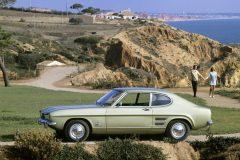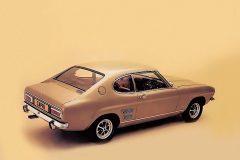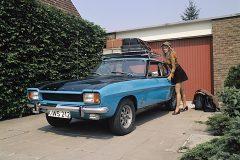It was a resounding success for Ford, the Mustang who made the relatively small, affordable sports car with space for four people in 1964. This inspired Ford of Europe to design a European coupe. That became the Ford Capri, which was presented to the general public at 1969 in Brussels and built in three generations. We describe the first generation (1969-1973).
The Ford Capri, which became Ford's European sports coupe, was designed on a platform of the Cortina. That was not done by a Brit, nor by a German. It was the American Philip Clark who put his signature, and actually translated the Mustang principles into Fords' new asset for Europe. Due to the size of Ford, various existing parts of other models could be integrated. However, the appearance was completely independent.
Dynamic lines, rear-wheel suspension old-fashioned
The long nose and the short rear of the self-supporting body gave the Ford Capri - the European Pony Car - a stretched and dynamic line that also looked modern for those years. That certainly did not apply to the chassis configuration of Fords' rear-wheel drive family coupe. It consisted of a rigid rear axle with semi-elliptical leaf springs at the rear. The front wheels were independently suspended and found suspension and damping according to the Mac Pherson principle. The application of (the number of) stabilizers was implementation dependent.
Engine choice is huge
The choice of engines was huge with the Ford Capri. The British variant was available with four-cylinder in-line Kent engines (1.3 and 1.6), and the 2.0 V4 Essex engine. The German versions had four-cylinders, recognizable by the typical V-sounds. They came from engines with cylinder capacities of 1.3, 1.5 and 1.7 liters. The engine range was expanded in 1969 with six-cylinders. From Germany came the 2.0 V6, the 2.3 V6, the 2.6 V6 (2.550 cc, 125 DIN-PK) and the 2.6 V6 (2.637 cc, 150 DIN-PK) that was mounted in the RS. The British in turn made a contribution to the six-cylinder bag by mounting the 3.0 Essex V6 engine. A striking feature was the Ford Capri Perana, which was built in a limited edition (1970 units) from 500 and was fitted with a 5.0 V8 Windsor engine, and was also used for competition purposes.
From 1.3 to RS
In addition, there were various equipment options. The most luxurious was the GXL, which was supplied with a leather roof below, and the most sporty was the 2600 RS. But the buyer could also be tempted to step into the most bare version, with an 1.3 engine in the front. Then you had an attractive car to see, but with poor performance. The delivery range and motorization depended on the country where the Ford Capri was sold. It was characterized by diversity and a lot of choice, whereby various variants could also be equipped with an automatic.
Facelift 1973
A facelift was planned for model year 1973. Certain sources call that facelift mild. Perhaps that relates to visibility, but Ford, contrary to what is claimed, did make work on the Ford Capri modification. The Ford was tackled on no less than 150 points. The most striking changes were the larger headlights, the modified dashboard, a changed steering wheel, a slightly different rear, the large V6 bubble on the hood that was now available on all versions, and the modified rear light section.
Other engines, reduced delivery range
Ford simplified the delivery offer and changed the engine range. The German four-cylinder Ford Capri's now replaced the V engines with line engines from the Taunus: the 1.3 and 1.6, which differed in configuration from the English Kent engines. The British stayed ahead their Ford Capri's stick to their choice of engines, and unlike other markets, the 2.0 V4 did keep the delivery range. The 2600 RS there by an 3000 RS and an 3100RS, both again with an Essex engine in the front, and an almost vertically placed rear spoiler. The 2600 RS remained available in other markets. The modified first-generation Ford Capri, for example, continued for a short while, so again the market-dependent supply ranges. In the Netherlands the offer was fairly austere, nine versions were planned for 1973. The ideal between engine, the 2.0 liter and the GXL were not among them, so there was a gap between the 1.6 and 2.3 engines and in the equipment options. The Capri I was replaced in January 1974 by the Capri II, the model with the third door.
One comma built two million times in different countries
The first generation of the Ford Capri was built from 1968 to 1974 1,2 million times. Ford produced it in Saarlouis, Cologne, Halewood, Genk, Homebush (Australia) and Port Elizabeth (South Africa). The Ford contributed greatly to the acceptance of the relatively affordable European family coupe, and is still very popular in classic circles today. And that certainly has to do with the versatility and design, which in relation to the Ford Capri always led to a bull's eye.












An acquaintance of an acquaintance (…) first drove a JAG mkII 3.8 aut. , but when the Capri became available with more power and a lower weight, he bought a Capri 2600 RS. My God, that thing was fast at the time. Insanely nice car!